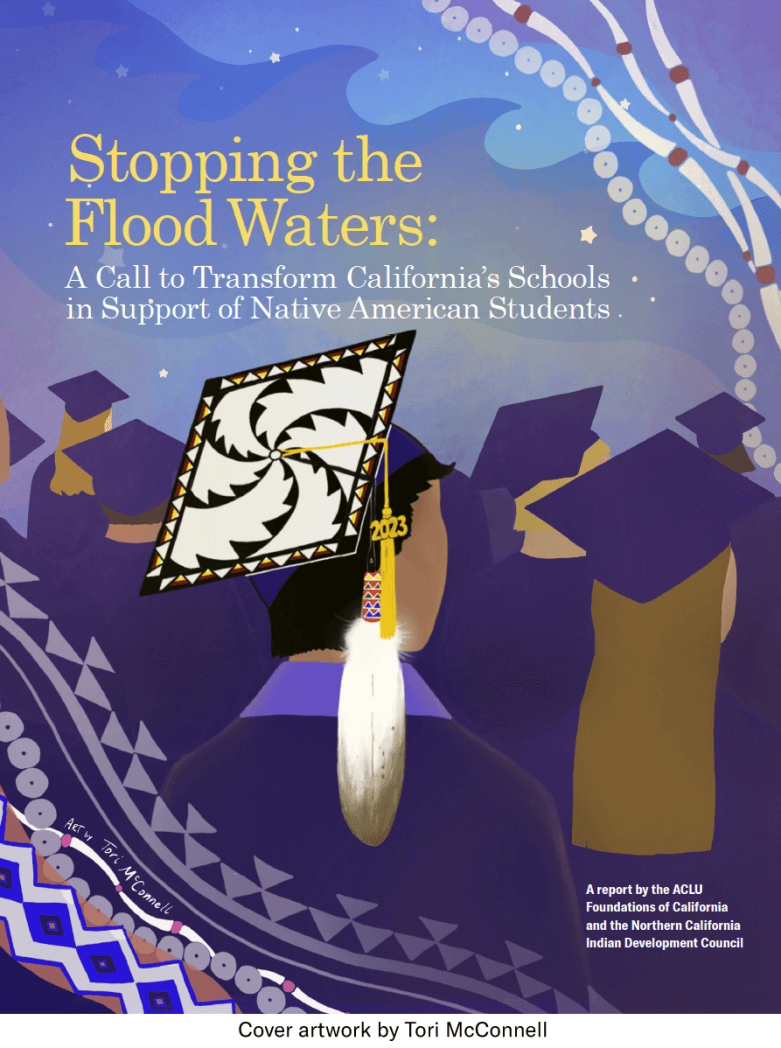Article Media

California's Native American students learn and grow amid a fundamental contradiction: while their families, cultures, and Tribes embrace education as central to their ways of life, California's school systems too often fail to provide them with an equitable and inclusive education.
The problem is compounded by inadequate reporting systems that render thousands of Native American students invisible in the data, making it difficult to document their experiences. Meanwhile, the accountability metrics that do exist reveal alarming educational disparities.
To address these challenges, the ACLU Foundation of Northern California, ACLU Foundation of Southern California, ACLU Foundation of San Diego and Imperial Counties, and Northern California Indian Development Council have released a new report that serves as a toolkit to support local and statewide advocacy to improve educational equity for Native American students.
Change is possible when educators, advocates, students, families, community members, and Native American Tribal leaders work to reshape California schools into spaces that genuinely recognize, respect, and nurture Native American students.
Key Report Findings:
Systemic Failures in California's School System
California's 2022–23 school accountability metrics show that many school systems are failing in their obligation to ensure educational equity for American Indian/Alaska Native students:
- Academic Achievement: 75% of districts report significantly lower assessment scores in English and math for American Indian/Alaska Native students.
- College Readiness: Among graduating seniors, only 32% of American Indian/Alaska Native students complete the necessary coursework to attend UC/CSU schools, compared to 45% of all students.
- Graduation Rates: 67% of reporting districts show lower graduation rates for American Indian/Alaska Native students.
- Discipline Inequity: Suspension rates for American Indian/Alaska Native students are more than double the overall student rate.
- School Stability: 75% of reporting districts show higher school instability rates for American Indian/Alaska Native students.
- Support Services: American Indian/Alaska Native students are disproportionately likely to attend schools lacking counselors, nurses, social workers, and psychologists.
California school data collection and reporting systems render thousands of Native American students invisible
Current educational data collection lumps diverse Indigenous peoples into a single “American Indian/Alaska Native” category.
- Most data reporting treats this category as exclusive of other racial or ethnic identities. This drastically undercounts American Indian/Alaska Native students in school accountability metrics and enrollment figures, making them appear to be less than one-half of one percent of California’s student population.
- School districts fail to collect Tribal identity information that could help identify and support students through federal programs.
California’s school system is rooted in the systematic ethnocide of Native American peoples
Throughout the late 19th and early 20th century, the state of California funded the trafficking of Native American children into indentured servitude and separated Native American children from their families, languages, cultures, and ancestral homelands into distant boarding schools that sought to eradicate their languages, cultures, and identities.
For over 150 years, California Tribes have vigorously defended their sovereignty from the violence and deceit of the U.S. government. Native American sovereignty includes the international human rights of Indigenous peoples to establish and access educational systems without discrimination, including education grounded in their own culture and language when possible.
CALL TO ACTION
Native American students and families in California have a strong history of resistance and resilience in the face of systemic oppression, and school systems can change when held accountable and given clear direction. There are proven ways to improve outcomes for Native students:
- Increasing tribal consultation and educational oversight
- Using culturally and linguistically relevant curriculum in the classroom
- Improving culturally competent professional development for school staff
- Conducting inclusive data counts
California must acknowledge the systemic harm inflicted on Native American students by its public school system and take immediate action to implement reforms. We urge the state and all California school districts to embrace Native American-led transformative school systems change.
CORRECTION
On page 28 regarding Jasmine Griffith's story, two errors were printed: (1) The class was Advanced Placement European History, not U.S. History; and (2) The correct title of the Indian Education Coordinator was "Native Educational Choices & Empowerment Project (NECEP) Career Coach”.
